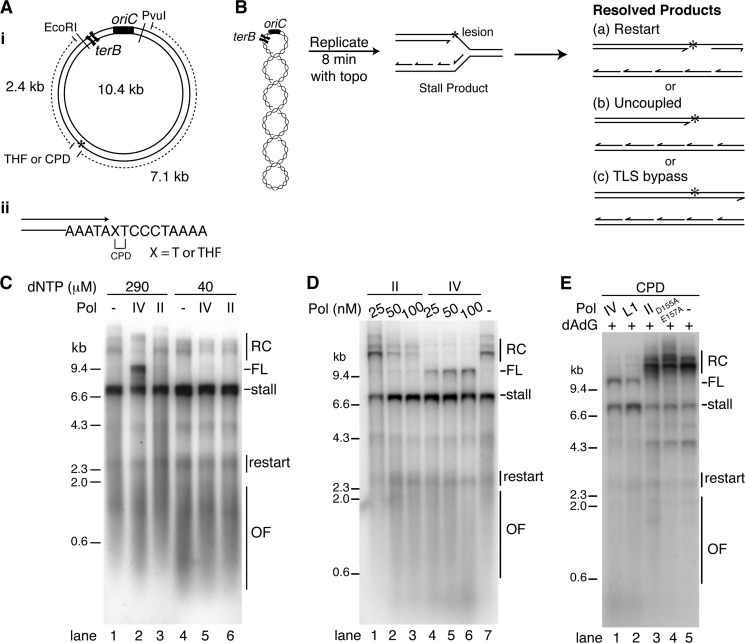FIGURE 3.
Pol IV, but not Pol II, catalyzes replisome-mediated TLS. A, DNA template. Panel i, map showing the positions of the leading strand template lesion relative to the origin of DNA replication, the Ter sites, and the relevant restriction sites used for analysis. Panel ii, DNA sequence about the site of the template lesion. B, replication reaction scheme showing the possible replicated DNA products. C, elevated nucleoside triphosphate concentration is required for Pol IV-catalyzed, replisome-mediated TLS on a THF template. Standard gyrase reactions containing the indicated TLS polymerase (100 nm Pol IV, 20 nm Pol II) and concentrations of dNTPS were incubated, processed, and analyzed as described under “Experimental Procedures.” D, Pol IV, but not Pol II, catalyzes replisome-mediated TLS. Standard gyrase replication reactions containing the THF template and the indicated concentrations of TLS polymerase, standard concentrations of dCTP and TTP, and 750 μm dATP and dGTP were incubated, processed, and analyzed as described under “Experimental Procedures.” E, Pol IV L1 (LF domain variant), but not Pol II D155A/E157A (the 3′ → 5′ exonuclease-defective variant), catalyzes replisome-mediated TLS. Standard gyrase reactions containing the indicated TLS polymerase (100 nm), standard concentrations of dCTP and TTP, and 750 μm dATP and dGTP were incubated, processed, and analyzed as described under “Experimental Procedures.” RC, greater than unit length, rolling circle DNA products that arise from nicks in the DNA template; FL, full-length nascent leading strand spanning the PvuI to EcoRI sites; stall, the nascent leading strand stall product spanning the distance from the PvuI site to the site of the template lesion; restart, nascent leading strands restarted downstream of the damage by leading strand lesion skipping; OF, Okazaki fragments. The extent of bypass in D, lanes 1–7, was (calculated as FL/FL + stall) 0.04 ± 0.01, 0.03 ± 0.01, 0.03 ± 0.01, 0.12 ± 0.04, 0.14 ± 0.03, 0.19 ± 0.04, and 0.03 ± 0.01, respectively (mean and standard deviation from four experiments). The extent of bypass in E, lanes 1 and 2, was 0.24 ± 0.1 and 0.1 ± 0.03, respectively (mean and standard deviation from three experiments). Representative gels are shown.

